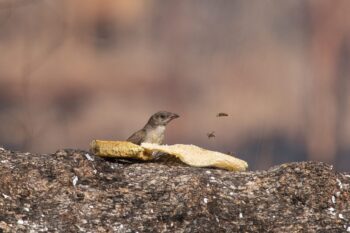In Eswatini, the Southern African country formerly known as Swaziland, people still commonly hunt for honey with the help of wild birds, a new study finds. This rare form of human-wildlife cooperation, which has disappeared from much of Africa, is expected to endure in Eswatini, sustained by tradition and peer-to-peer learning, researchers say.
Only in a handful of places in Africa do people still work with honeyguide birds (Indicator indicator) to find wild bees’ nests. In Eswatini, researchers interviewed 80 honey-hunters and found the practice is widespread and involves several key steps: summoning the birds through whistles and sounds; keeping them engaged as they lead the way to bees’ nests; subduing the honeybees (Apis mellifera scutellata) and harvesting the honey; and rewarding the birds with beeswax.
These skills are typically “vertically” passed down to younger generations by older family or community members. But in Eswatini, they’re also horizontally shared among young hunters, researchers found.
“It’s more of a pastime that young boys do while they’re out herding cattle, so most of the time the information transfer, as opposed to it being vertical from adults to children, in Eswatini, it is mostly horizontal, shared between young boys while they’re out there having fun,” said study lead author Sanele Nhlabatsi from the University of Eswatini.
“The fact that both vertical and horizontal information transfer facilitates the spread of this culture, in between and within generations, also plays a huge role [in sustaining it].”
This recreational aspect sets Swati honey-hunters apart from communities such as the Yao, in northern Mozambique, where honey-hunting with honeyguides supplements livelihoods, nutrition and income.
Only eight of the interviewed honey-hunters said they sold honey for income. The practice can therefore persist without economic incentives, Nhlabatsi said.
“The fact that it is not the main [source of] income, but people still do it anyway, means it is unlikely that people stop doing it because they’ve found a different source of income.”
The study also revealed modern twists. Traditionally, some hunters whistle on the dried, hollowed-out, spherical fruit of hedge caper bushes (Capparis sepiaria) to summon honeyguide birds. But some young hunters now recreate these whistles using plastic balls from roll-on deodorant sticks, especially when the fruit is out of season.
Wiro-Bless Kamboe, a conservation biologist at the University for Development Studies in Ghana, who wasn’t involved in the Eswatini study, said the findings resonate with his own research in northern Ghana where honey-hunting with honeyguides persists despite rapid social and economic change.
Unlike in Eswatini, though, knowledge transfer in Ghana is predominantly vertical, with hunters passing skills down to sons and close relatives. “It’s fascinating how the knowledge is passed on differently,” Kamboe told Mongabay.
“While many [Ghanaian] honey-hunters say wild bees’ nests are becoming scarcer, most believe the practice will continue as long as young people remain interested.”
Banner image: A female greater honeyguide eating wax combs left behind by a honey-hunter. Image courtesy of Dom Cram.





